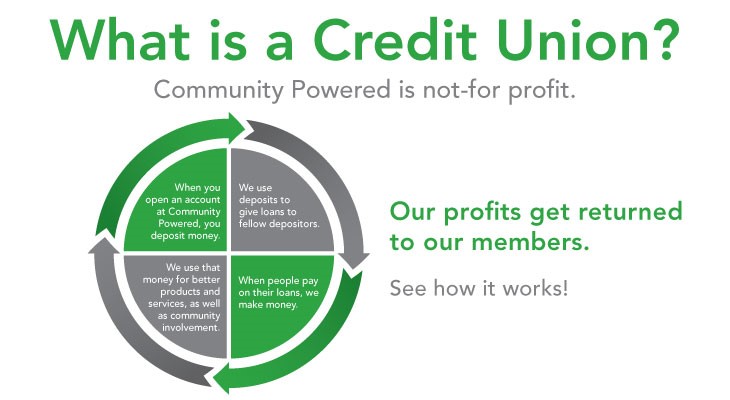The Ultimate Guide to Comprehending Lending Institution

Credit history unions stand as distinct monetary entities, rooted in concepts of common support and member-driven procedures. As we navigate through the complexities of credit rating unions, an insightful trip awaits to drop light on these member-focused organizations and how they vary from traditional banks.
What Are Lending Institution?
Lending institution are member-owned banks that provide a variety of banking services to their members. Unlike conventional banks, lending institution operate as not-for-profit companies, meaning their key emphasis is on offering their members instead than optimizing earnings. Members of a credit scores union usually share a typical bond, such as benefiting the very same company, belonging to the very same area, or belonging to the very same company.
One of the vital advantages of credit rating unions is that they often provide higher passion rates on financial savings accounts and reduced rate of interest on financings compared to financial institutions. Credit Union in Wyoming. This is due to the fact that cooperative credit union are structured to profit their participants directly, permitting them to pass on their profits in the kind of far better rates and less charges. Furthermore, credit report unions are known for their customized customer support, as they prioritize building connections with their participants to understand their distinct financial demands and goals
Background and Advancement of Credit History Unions
The roots of member-owned monetary cooperatives, known today as lending institution, trace back to a time when communities looked for options to traditional banking institutions. The concept of credit report unions come from in the 19th century in Europe, with Friedrich Wilhelm Raiffeisen frequently credited as the pioneer of the participating financial motion. Raiffeisen founded the initial recognized debt union in Germany in the mid-1800s, highlighting community assistance and self-help concepts.
The advancement of credit rating unions continued in The United States and Canada, where Alphonse Desjardins established the very first cooperative credit union in Canada in 1900. Soon after, in 1909, the first united state credit rating union was formed in New Hampshire by a team of Franco-American immigrants. These early lending institution operated the basic principles of common assistance, autonomous control, and participant possession.
With time, lending institution have grown in appeal worldwide due to their not-for-profit framework, concentrate on offering participants, and using competitive monetary products and services. Today, lending institution play an important duty in the monetary sector, supplying obtainable and community-oriented financial choices for services and individuals alike.

Membership and Eligibility Standards
Subscription at a cooperative credit union is commonly restricted to individuals satisfying certain qualification requirements based upon the organization's starting principles and governing requirements. These standards frequently include aspects such as geographical location, work status, membership in certain organizations, or affiliation with details teams. Cooperative credit union are known for their community-oriented strategy, which is reflected in their subscription demands. Wyoming Credit Union. For example, some cooperative credit union may just serve people that try these out live or function in a certain area, while others may be customized to workers of a particular company or participants of a particular association.
In addition, credit rating unions are structured as not-for-profit organizations, implying that their key goal is to offer their participants rather than generate revenues for investors. This focus on participant service frequently converts into even more personalized focus, reduced costs, and competitive rate of interest on savings and financings accounts. By meeting the eligibility standards and ending up being a member of a cooperative credit union, people can access a series of financial services and products tailored to their details needs.
Services and Products Provided
One of the vital aspects that sets credit score unions apart is the varied array of economic solutions and products they provide to their members. Credit score unions generally offer typical banking solutions such as cost savings and checking accounts, lendings, and debt cards.
Furthermore, credit score unions commonly provide hassle-free online and mobile banking choices for members to quickly manage their funds. They might provide advantages such as shared branching, allowing participants to access their accounts at other cooperative credit union throughout the country. Some cooperative credit union also supply insurance coverage items like life, vehicle, and home insurance to assist participants secure their possessions and liked ones.

Benefits of Banking With Cooperative Credit Union
When thinking about monetary establishments, checking out the benefits of financial with lending institution exposes one-of-a-kind advantages for participants looking for personalized solution and affordable rates. One significant benefit of cooperative credit union is their concentrate on personalized customer support. Unlike large financial institutions, cooperative credit union are member-owned home and focus on building strong partnerships with their participants. This suggests that credit score union staff often have a much deeper understanding of their members' monetary requirements and can provide customized services to aid them attain their objectives. In addition, credit unions are recognized for More Help providing affordable rate of interest on lendings and cost savings accounts. Due to the fact that they are not-for-profit organizations, credit scores unions can commonly supply reduced funding prices, greater cost savings rates, and lower costs compared to traditional banks. This can result in significant price financial savings for participants in time. In general, banking with a lending institution can provide a much more personalized, affordable, and member-centric economic experience.
Final Thought
To conclude, cooperative credit union attract attention as member-owned financial organizations that focus on offering their members over maximizing earnings. With beginnings going back to 19th century Europe, cooperative credit union follow principles of common aid and participant ownership. They use a series of financial product and services, including standard banking solutions, financial investment options, and competitive rate of interest. Subscription qualification standards specify and show a community-oriented method, giving individualized client service and a member-centric financial experience.
Credit report unions are member-owned monetary organizations that use a variety of financial solutions to their members. The idea of credit unions stem in the 19th century in Europe, with Friedrich Wilhelm Raiffeisen commonly credited as the pioneer of the participating banking movement.The advancement of credit unions proceeded in North America, where Alphonse Desjardins established the very first credit rating union in Canada in 1900. Debt unions normally offer traditional financial solutions such as savings and examining accounts, loans, and debt cards.When considering financial establishments, checking out the advantages of financial with credit score unions reveals distinct advantages for members seeking personalized service and affordable rates.